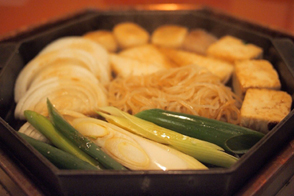
What's konjac?
Konjac is made of corm that grows in a part of Asia, especially Japan.
It is one of Japanese unique traditional foods which a texture is similar with collagen or nata-de-coco.
It is famous for a rich source of dietary fiber known as 'glucomannan'.
Glucomannan is stated that has the effect of discharging harmful substances in the intestines and lowering blood pressure and cholesterol.
This could be ideal for preventing a lifestyle disease by adding konjac as one of your daily meals.
Moreover, it offers very low calories which gives 8 kcal/ per 100g, and it contains a rich soure of dietary fiber.
Konjac is also known as no carbohydrate or sugar in nutrition. Therefore, it is becoming one of dietary and healthy foods around the world.
A noodle version of konjac is called "Shirataki" has been very popular by substiting of wheat noodles(spaghetti, ramen noodle etc.) in Europe, Asia and so on.

Cooking example of konjac
Sukiyaki

Sukiyaki is a Japanese hotpot dish of beef and vegetables simmered in a soy sauce-based soup, and one of the ingredients is shirataki.
ODen

Oden is a traditional Japanese dish made by simmering various ingredients.
KINPIRA

Kinpira is a dish of thinly sliced konnyaku, burdock, and carrots stewed in soy sauce and sugar.
Konjac noodles

Konjac noodles are made by adding soybean powder to shirataki. It can be used for various dishes such as pasta, ramen, and fried noodles.
Konjac steak

Konjac steak is a dish of fried konjac in a garlicky steak sauce.
Konjac salad

Konjac salad is a dish of thinly sliced konjac, cucumber, carrot, and dressing. It is a popular menu item in Japanese school lunches.
How to produce Konjac

- Harvested konjac corms are washed, sliced and dried. Remove the skin and grind it into powder.
- Dissolve konjac powder in water.
- Dissolve edible calcium hydroxide in water to make lime water.
- Add step 3 to step 2 and mix well.
- Put step 4 in the mold and put it in boiling water to harden.
- Cut the hardened Konjac into more than 100 different shapes.
About Kabura Shokuhin
Since our establishment in 1984, Kabura Shokuhin have been manufacturing and selling konnyaku in Gunma-ken, Japan.
We can cut konjac in more than 100 different shapes.
In addition, it is possible to produce more than 40 tons per day.
In order to provide safe and secure konjac products, we use high-quality refined "konjac powder" and conduct thorough hygiene and quality control.
We have more than 20 years of experiences in exporting overseas.
We export "Konjac" and "Shirataki noodles" to around the world.
Corporate Data
| Corporate Name | Kabura Shokuhin |
|---|---|
| Establishd |
October 1984 |
| Head Office |
1482 Nanjai,Tomioka-shi,Gunma-ken, Zip370-2464,Japan |
| Main Business Activities |
Manufacture and sell "konjac" products |
| Konjac | For retail commercial & industrial use konjac, and commercial products on the market |


Factory Certificate The factory has “JFS-B” standard.”JFS-B” is a food safety standard developed in Japan. It consists of 3 layers of requirements:
①Management System (FSM)
②Hazard Control (HACCP)
③Good Manufacturing Practice (GMP)
Contact us
We will reply to inquiries from the mail form within 3 business days. We do not respond to advertisements.
★ is a required item.
A confirmation e-mail will be sent automatically to your e-mail address.
Please make sure that your e-mail address accepts e-mails from “@kaburafc.com”.
